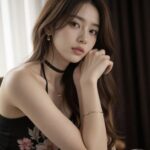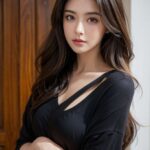Virtual Queens: The Art of Beautiful Women Created by AI sets the stage for this enthralling narrative, offering readers a glimpse into a story that is rich in detail and brimming with originality from the outset. As we delve into the world of AI-generated beauty, we uncover a fascinating blend of artistry and technology that is reshaping our perceptions of beauty and creativity.Explore the evolution of AI in art and beauty, delve into the techniques used to create these virtual queens, and ponder the ethical considerations and cultural impacts of this digital phenomenon. Brace yourself for a journey through the intersection of artificial intelligence and beauty, where innovation meets imagination to redefine the concept of beauty in the digital age.
 Artificial Intelligence (AI) has made significant strides in the world of art and beauty, revolutionizing the way we perceive and create beauty. Let's delve into the history of AI's involvement in art creation and its impact on the beauty industry.
Artificial Intelligence (AI) has made significant strides in the world of art and beauty, revolutionizing the way we perceive and create beauty. Let's delve into the history of AI's involvement in art creation and its impact on the beauty industry.
 Creating AI-generated beautiful women involves a combination of advanced algorithms and processes to achieve realistic and aesthetically pleasing results. Machine learning plays a crucial role in refining these virtual representations by analyzing and learning from vast amounts of data to continuously improve the generated images.Let's delve into the techniques used in creating Virtual Queens:
Creating AI-generated beautiful women involves a combination of advanced algorithms and processes to achieve realistic and aesthetically pleasing results. Machine learning plays a crucial role in refining these virtual representations by analyzing and learning from vast amounts of data to continuously improve the generated images.Let's delve into the techniques used in creating Virtual Queens:
 Artificial Intelligence has revolutionized the way we create and perceive beauty, but it also raises important ethical considerations that need to be addressed. One of the key concerns is the perpetuation of unrealistic beauty standards through AI-generated images and models.These virtual queens, although stunning and flawless, may set unattainable ideals for real individuals, leading to feelings of inadequacy and body dissatisfaction.
Artificial Intelligence has revolutionized the way we create and perceive beauty, but it also raises important ethical considerations that need to be addressed. One of the key concerns is the perpetuation of unrealistic beauty standards through AI-generated images and models.These virtual queens, although stunning and flawless, may set unattainable ideals for real individuals, leading to feelings of inadequacy and body dissatisfaction.
Introduction to Virtual Queens
Virtual Queens are digital representations of beautiful women that have been created using artificial intelligence (AI) technology. These virtual queens exist solely in the digital realm and are a blend of creativity, artistry, and cutting-edge technology.AI plays a crucial role in generating these virtual queens by utilizing algorithms to design their features, hairstyles, outfits, and overall appearance.Through AI, these virtual queens can possess unique and intricate details that may not be achievable through traditional methods of art creation.The Intersection of Art and Technology
Art and technology converge seamlessly in the creation of Virtual Queens. Artists harness the power of AI to bring their creative visions to life, pushing the boundaries of what is possible in the realm of digital art. The fusion of artistry with technological advancements results in stunning and lifelike virtual queens that captivate audiences and redefine the concept of beauty in the digital age.Evolution of AI in Art and Beauty
 Artificial Intelligence (AI) has made significant strides in the world of art and beauty, revolutionizing the way we perceive and create beauty. Let's delve into the history of AI's involvement in art creation and its impact on the beauty industry.
Artificial Intelligence (AI) has made significant strides in the world of art and beauty, revolutionizing the way we perceive and create beauty. Let's delve into the history of AI's involvement in art creation and its impact on the beauty industry.
AI in Art Creation
AI's involvement in art creation dates back to the 1960s, with early experiments in computer-generated art. Over the years, AI has been used to create paintings, sculptures, and even music. One notable example is the AI-generated portrait "Edmond de Belamy," which was sold at auction for over $400,000.AI algorithms can analyze patterns and styles from existing artworks to generate new and unique pieces, blurring the lines between human and machine creativity.AI in the Beauty Industry
AI has also made a significant impact on the beauty industry, transforming how we perceive and define beauty standards. With the rise of beauty filters and virtual makeup try-on tools, AI has enabled users to experiment with different looks and enhance their features digitally.Beauty brands are leveraging AI technology to personalize skincare and makeup recommendations based on individual preferences and skin types. AI-powered beauty devices can analyze skin conditions and provide tailored solutions, revolutionizing the way we approach beauty routines.Traditional Beauty Standards vs. AI-generated Beauty
Traditional beauty standards have long been shaped by societal norms and cultural influences, often promoting unrealistic ideals of beauty. AI-generated beauty, on the other hand, challenges these traditional standards by celebrating diversity and individuality. AI algorithms can create digital avatars and models that represent a wide range of skin tones, body types, and features, promoting inclusivity and self-expression.By showcasing a more diverse and inclusive vision of beauty, AI has the power to redefine beauty standards and empower individuals to embrace their unique beauty.Techniques Used in Creating Virtual Queens
 Creating AI-generated beautiful women involves a combination of advanced algorithms and processes to achieve realistic and aesthetically pleasing results. Machine learning plays a crucial role in refining these virtual representations by analyzing and learning from vast amounts of data to continuously improve the generated images.Let's delve into the techniques used in creating Virtual Queens:
Creating AI-generated beautiful women involves a combination of advanced algorithms and processes to achieve realistic and aesthetically pleasing results. Machine learning plays a crucial role in refining these virtual representations by analyzing and learning from vast amounts of data to continuously improve the generated images.Let's delve into the techniques used in creating Virtual Queens:
Generative Adversarial Networks (GANs)
- GANs are a popular technique used in creating AI-generated images, including virtual representations of beautiful women.
- This approach involves two neural networks - a generator and a discriminator - that work together to generate high-quality images.
- The generator creates new images based on input data, while the discriminator evaluates the generated images to ensure they are realistic.
Style Transfer
- Style transfer techniques allow artists and designers to apply the artistic style of one image to another, creating unique and visually appealing results.
- By leveraging machine learning algorithms, style transfer can be used to enhance the aesthetics of virtual queens by incorporating different visual styles into their representations.
- Popular tools like TensorFlow and PyTorch provide frameworks for implementing style transfer algorithms effectively.
Ethical Considerations in AI-Generated Beauty
 Artificial Intelligence has revolutionized the way we create and perceive beauty, but it also raises important ethical considerations that need to be addressed. One of the key concerns is the perpetuation of unrealistic beauty standards through AI-generated images and models.These virtual queens, although stunning and flawless, may set unattainable ideals for real individuals, leading to feelings of inadequacy and body dissatisfaction.
Artificial Intelligence has revolutionized the way we create and perceive beauty, but it also raises important ethical considerations that need to be addressed. One of the key concerns is the perpetuation of unrealistic beauty standards through AI-generated images and models.These virtual queens, although stunning and flawless, may set unattainable ideals for real individuals, leading to feelings of inadequacy and body dissatisfaction.

